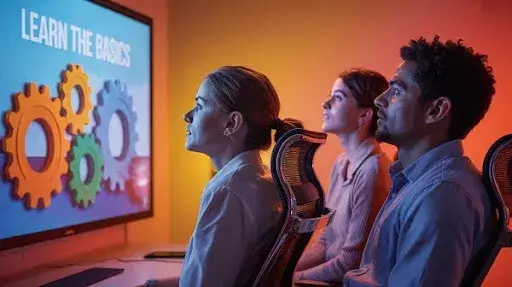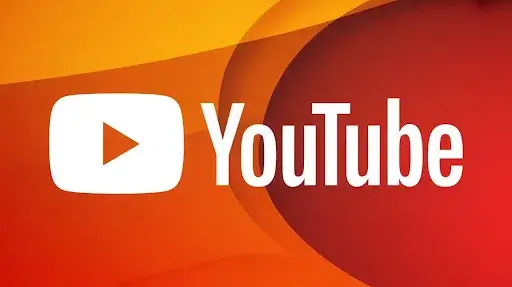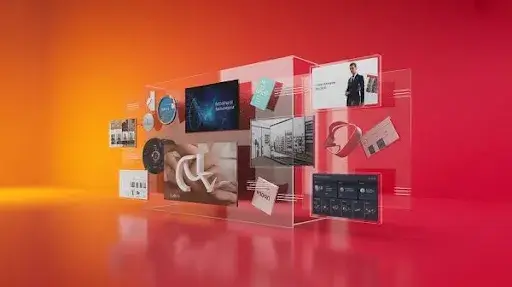Scroll through any feed and you’ll notice something: the clips that actually make you pause are often animated. Not the ultra-polished 3D robots or cinematic effects, but clever, stylish 2D animation. Two-dimensional animation has a certain charm. It feels simple yet sharp, nostalgic for some and refreshingly modern for others. When brands get it right, the result sticks.
For businesses looking for ideas, real 2D animation examples are the best way to see what works. Flat shapes and colors can be transformed into stories that stay in people’s heads. Before we go through some of the best ones, let’s clear up the basics.
What is 2D Animation?
2D animation is all about creating movement on a flat surface. Characters, icons, or objects are drawn or designed digitally, then animated frame by frame to bring them to life. Unlike 3D animation, it doesn’t create depth—you’re working with a flat plane.
The tools have changed over the years. Hand-drawn sketches have largely given way to digital programs. But the core has not changed. A movement speaks, and it speaks elegantly and accessibly. That’s why businesses continue to use 2D animated videos—it fuses imagination with a viable approach.
Honda “Paper”
Target Industries: Automobile and Transportation
Collaborated With: General Public
Honda’s “Paper” is a classic. The commercial plays out like a giant flipbook, made from thousands of hand-drawn frames. Every sequence was captured in-camera, which gave it a raw, handmade quality that software just can’t mimic.
The genius is not in the cars that roam the screen, but in the narrative. The video guides the audience through Honda’s evolution, celebrating the spirit of innovation. That bigger picture made it memorable and turned a simple 2D animation example into an Emmy-nominated piece.
Down the Rabbit Hole
Target Industries: Music Festival Promotion
Collaborated With: Agent Pekka and General Public
This one is bold and loud. Down the Rabbit Hole is a frenzy of colors, shapes and movement—it’s chaos, but ordered chaos. The entire work is a masterpiece, hypnotic to watch. Every shape is intricately keyframed.
It’s a reminder that two-dimensional animation doesn’t always need characters or dialogue. Sometimes it’s about energy and sensation. For a music festival, that approach makes total sense. The video sells the vibe before the first note is even played.
MailChimp
Target Industries: Social Media, Paid Media, E-Commerce
Collaborated With: Canva, Shopify
When MailChimp added Facebook Ads integration, they faced a tricky challenge: how do you explain a technical feature without boring your audience? Their answer was a short 2D explainer video.
This is where the benefits of 2D animation shine through. The visuals keep it light and approachable, while the script trims away the complexity. Viewers walk away understanding the feature without feeling lectured. It’s proof that engaging animation video content doesn’t have to be flashy—it just needs to make sense.
HubSpot CMS
Target Industries: Marketing, Sales, Service
Collaborated With: WWF, eBay, Kelly
HubSpot’s “What is CMS?” video could’ve been dry. Instead, they went playful. Bright visuals, upbeat pacing, and a positive tone gave it a friendly personality.
The magic is in its clarity. Even someone who’s never heard of CMS can follow along. That’s the mark of high-quality animation video production—it breaks down complex tools into easy-to-digest visuals without losing the fun.
CMYK
Target Industries: Enterprise, Customer Service
Collaborated With: Undisclosed
CMYK proves that less can be more. The animation doesn’t rely on over-the-top effects. Instead, it uses subtle touches—an eyebrow raise, a head tilt—to bring flat shapes to life.
A lesson in focus. By concentrating on the shapes that make up the characters, the animators infused them with life and depth. A proof that complex animation does not necessarily have to come with extravagant techniques. Sometimes it’s the quiet choices that grab attention.
Slack
Target Industries: Engineering, IT, Customer Service
Collaborated With: Airbnb, Uber, NASA
Slack’s 2D animation video strikes a balance: it explains the app while also building a sense of community. The style is clean, modern, and approachable.
For software companies, this is a solid example of 2D animation services in action. It solves, informs and educates. It provides a sense of approachability, making the platform less daunting for new users. A balance of transparency and marketing.
Google Cloud
Target Industries: Tech, Digital Marketing
Collaborated With: General Public
Google Cloud showed how simple 2D motion graphics can unpack something as big as artificial intelligence. Their “Navigating AI” video runs under 60 seconds, and it doesn’t even need a voiceover.
The visuals alone carry the explanation. Clean graphics, smart sequencing, and sharp timing turn a tough topic into something anyone can grasp. A perfect showcase of engaging animation video that educates without overcomplicating.
McDonald’s
Target Industries: Food, Tech, Environment
Collaborated With: General Public
The 2D animation for the Car Free Day campaign by McDonald’s was playful, vibrant, and animated, featuring whimsical characters—such as elephants walking through the drive-thru.
The charm here is in the tone. Instead of preaching about sustainability, it turned the message into fun storytelling. That keeps the brand approachable while still sending a clear signal about eco-conscious values.
Deloitte
Target Industries: Consumer, Financial, IT
Collaborated With: Confidential
Deloitte blended 2D, 2.5D, and a hint of 3D for its “Future of Mobility” project. The smooth transitions between dimensions created depth without losing the flat, clean feel of two-dimensional animation.
By pairing a futuristic theme with advanced techniques like toon shading, the video pulled viewers into a smart, forward-looking narrative. It’s a polished example of how 2D animation services can adapt to modern expectations.
Etsy Plus
Target Industries: E-Commerce, Lifestyle
Collaborated With: General Public
Etsy launched its premium seller service with a bright, textured 2D animation video. Every frame was designed with personality, from animated objects to quirky transitions.
The strong voiceover guided the story while the visuals kept it charming. It was informative without being dull—something every brand should aim for. As far as examples of 2D animation go, this one proves how style and substance can work together.
Benefits of 2D Animation
Scroll through a few marketing campaigns today and you’ll notice something: 2D animation hasn’t faded into the background. It’s not just about nostalgia or “cartoon vibes.” Brands are still using it because it works.
A new startup might lean on it to explain an app in 60 seconds, while a global company could use the same approach to launch a product across different countries. Different scales, same result—2D animation keeps ideas simple, clear, and watchable.
Affordable Without Looking “Cheap”
Let’s be real: live-action ads and 3D productions can burn through a budget quickly. You’ve got equipment rentals, actors, set design, licenses, plus weeks of editing. It stacks up fast.
2D animation avoids most of that hassle. A smaller creative unit is still able to produce work that is clean, sophisticated and professional—at a fraction of a marketing budget.
For a small business, that might mean the difference between having no video presence or being able to publish a slick explainer that builds trust. For larger companies, it means creating multiple campaign versions—different languages, different regions—without having to reshoot everything.
Flexible Enough for Any Industry
What makes 2D stand out is how easily it fits across industries. A restaurant can use animation to roll out a seasonal menu. A fintech startup can use it to unpack “compound interest” without putting viewers to sleep. Hospitals use it for patient education, while lifestyle brands might use it to show off a product drop with style.
That flexibility keeps 2D animation services in constant demand. The same creative team can pivot tone and visuals depending on the client. Playful for sneakers, serious for finance, warm and human for healthcare. It’s adaptable by design—and that adaptability saves time and budget.
A Style That Feels Approachable
Big-budget realism isn’t always necessary. In fact, it can sometimes distract from the message. With 2D, you get a lighter, friendlier look that feels more approachable.
Slack’s explainer videos are a great example. They weren’t flashy, but they were easy to watch, casual, and clear. That’s the magic of 2D: people aren’t overwhelmed by special effects. They pay attention to what’s being said.
In short, the format pulls focus onto the story. And when the story sticks, the brand message sticks too.
Building a Recognizable Identity
Animation can become part of a company’s identity, not just a one-off creative choice. A repeated color palette, character style, or even a certain rhythm of movement can become as recognizable as a logo.
Mailchimp leaned into quirky, slightly odd animations that matched its brand personality. Etsy went the opposite direction, keeping their style neat and modern. Both worked, because they stayed consistent. Over time, audiences began to associate the animation style itself with the company. That kind of recognition is hard to buy—but easy to build with repetition.
Simplifying the Complicated
Try filming “cloud storage” or “encryption.” You can’t. These ideas don’t have a physical form. That’s where 2D animation steps in.
To explain elusive ideas, companies such as HubSpot and Google Cloud often employ animated explainers as an effective visualization tactic. In a sophisticated context, a wordy account that consists of several paragraphs can be reduced to a few easy shapes and movements.
It’s efficient. It’s clear. And it works across audiences—whether you’re talking to a CEO, a student, or someone scrolling Instagram on their commute.
Why Professional Studios Beat Templates
Yes, drag-and-drop animation apps exist. They’re fine if you just need a quick Instagram Story. But here’s the catch: people notice when a video looks generic. Templates all start to feel the same.
A professional studio can push things further. At Prolific Studio, for example, projects go beyond “moving graphics.” The process encompasses scripting, storyboarding, and polishing—such as character work done frame by frame, fluid transitions, and blending 2D and 2.5D graphics for depth.
The sass, however, is more of an art. It is justified without the need for borders and padding. However, padding is usually present, and the effort made is reflected in clicks, sign-ups, purchases, and ongoing revenue streams.
Why 2D Animation Still Holds Its Edge
Marketing tools change fast. One year it’s TikTok challenges, the next it’s AR filters. But 2D animation keeps holding its ground. Why? Because it adapts.
This applies to product explainers, social ads, onboarding videos, and even staff training. All of which are easy to update, repurpose, and add in themed sticky digital malarkey.
The entertainment and light approach it provides makes it preferable to the audience, while its practicality and efficiency earn the appreciation of the brands. The reason 2D is still around is the admirable and rare balance between the two.
Frequently Asked Questions
Where is 2D animation used today?
Used for advertising, education, social campaigns, training videos, and entertainment, it can be dubbed universal. Whether in a startup to launch a product, or a Fortune 500 to scale the messaging, it can be used in all contexts.
Why pick 2D over 3D?
2D is faster and more budget-friendly. 3D is great when realism is needed, but 2D often communicates ideas more clearly, especially for storytelling.
Is it affordable for small businesses?
Yes. With the right studio, even smaller budgets can produce professional, on-brand content.
What makes an animation engaging?
A clear story, good pacing, and a visual style that feels intentional—not rushed. When those align, people remember the video instead of scrolling past it.
Can 2D handle technical subjects?
That’s one of its strengths. Abstract concepts—like SaaS tools, medical processes, or financial systems—are easier to explain with visuals.
How do I know if my business needs it?
If your message feels too complex, or if your current content isn’t sticking, 2D animation can bridge the gap. It’s a strong choice when clarity and memorability matter.
Final Words
From Honda’s flipbook-style campaign to Etsy’s clean launch videos, 2D animation keeps proving its range. It can be playful, bold, educational, or emotional—whatever the story calls for.
At the end of the day, the draw is simple: it makes messages easy to grasp and hard to forget. And for businesses, that’s worth its weight in gold.
If you’re ready to put your brand’s story in motion, Prolific Studio, one of the best animation studios in Hollywood, can help. Our team blends creativity and strategy to deliver animation video content that doesn’t just look good—it performs.







